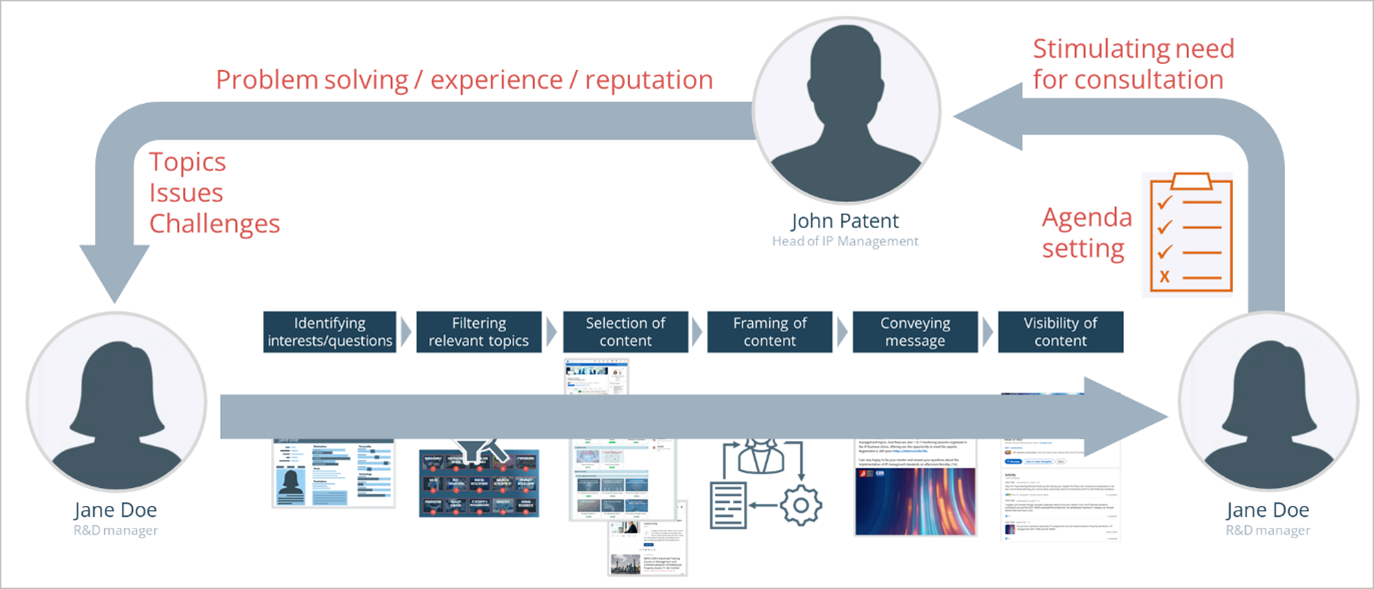IP Awareness Building under New Work Conditions: Framing of content
There are a number of reasons why IP professionals should think about creating awareness of IP and IP management. As the interim results of our study on Awareness Building for IP under New Working Conditions show, it makes sense for the business development of IP professionals and IP law firms to build a dedicated and topic-focused professional brand. For business development purposes, it is useful for the IP expert to create awareness of the issues with which he or she wishes to be associated in his or her community.
Creating awareness of IP is also an essential part of implementing standards-compliant IP management. Both ISO 56005 (Innovation Management – Tools and Methods for Intellectual Property Management) and DIN 77006 (Intellectual Property Management Systems) require that the necessary awareness for dealing with IP be created among the company’s employees. This means, in particular, that employees who are not IP experts by themselves must be made aware of the points at which they come into contact with IP in their areas of responsibility. In addition, it is important to ensure that those corporate functions that are not actually involved in IP have sufficient expertise to deal with IP properly in their day-to-day work.
Lack of interest in IP among non-IP professionals
In the task of raising awareness of IP, it is important to recognise that the acquisition of these skills is often not the focus of non-IP professionals. IP issues are seen as complex and unwieldy, and are often perceived as a hindrance to the performance of one’s duties. In addition, IP is often only one of a number of issues that non-IP professionals need to be aware of. In order to raise awareness of IP, it is therefore necessary to create the motivation to deal with the relevant issues, if not to overcome internal resistance. To this end, it is necessary to regularly demonstrate the relevance of IP for the fulfilment of tasks in the respective corporate functions and how the necessary knowledge of IP leads to a better performance of one’s own work.
One instrument that can be used to achieve this is so-called “framing“.
Framing: A concept from psychology
In communication and psychology, framing refers to the way in which an issue or message is presented to influence the recipient’s perception and interpretation. A “frame” is an interpretative framework or thought structure that promotes and supports a particular interpretation of events, facts or actions. Frames are thus a kind of mental category that help us to simplify and organise complex information, but also to favour certain perspectives and interpretations and exclude others.
Framing can be conscious or unconscious and there are different types of frames, such as cultural, political or media frames. Framing is often used to promote one’s own interests or to present certain issues and problems in a certain light. It is important to understand that framing has nothing to do with deception or misinformation. It is simply a way of presenting facts in a different way so that people see the positive aspects and the relevance of a piece of information to their actions.
For raising IP awareness, framing can be used to overcome internal resistance to dealing with IP-related issues, to show the relevance of IP to one’s own work, and thus to motivate people to acquire the necessary IP-related skills through targeted learning.
The process of framing for IP awareness
In order to be able to frame IP-related content in a targeted way, it is necessary to create the right conditions:

- Creating a persona
First of all, it is important to get a picture of the target audience for whom IP awareness is to be created. This is done by using a marketing concept called a “persona”. A persona is a typical representative of a target group. The creation of a persona helps to better characterise your target group and to get an idea of typical motivation and frustration factors, for example. - Creating a target competency profile
As already described in this blog post, it is necessary to create a profile that shows where the target group comes into contact with IP-related issues and what competences are required to deal with IP properly in the tasks assigned to the target group. This will provide information on what content needs to be communicated to the target group and how it needs to be framed. - Content repository
Awareness raising must always go hand in hand with the provision of information. There must be a content repository, for example in the form of a content portal, where the relevant content is available. From this content, those are selected that contribute to solving the (presumed) IP related problems that non-IP experts have in carrying out their work. - Framing
This content needs to be brought closer to the target audience. The aim is to change a negative perception of the issue and create positive associations and relevance in the minds of the target audience. For example, characteristics of the persona, especially motivations and frustrations, can be taken up and addressed in the communication. It is important to place the IP issue in the context of the target audience’s reality in order to demonstrate its relevance to the individual. The use of positive frames, e.g. positive wording and images, should evoke positive emotions that can overcome negative attitudes towards IP. In addition, the IP professional should be careful not to use IP jargon in his or her communication, but to use language that is closer to the target audience. This can also help to reduce the barriers for other business functions to engage with IP issues. Depending on the type of awareness-raising content being offered, it may also be useful to use framing not only when addressing non-IP professionals, but also when preparing the content itself.

Such an approach greatly increases the likelihood that non-IP experts will recognise the relevance of certain IP-related issues to their own activities and begin to address them. In this way, the IP expert sets the agenda for his target group. By engaging more with the topic, non-IP experts also become more aware of their own need for consultation, which can then be met by the content provider. This creates a deeper relationship with the target group, in which other topics can be addressed.



